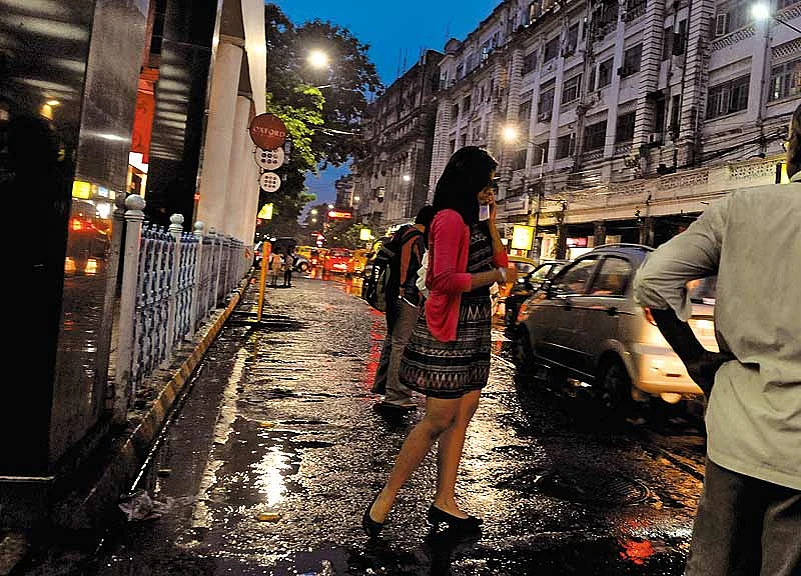Not long before visuals of the young girl attacked in Guwahati went viral last week and kept reappearing on our TV screens, there was a similar incident in the same city that was also filmed by a TV crew and posted online. In December 2010, a young, English-speaking Mizo girl dressed in western clothes had lost her way in the city after a late-night wedding and was accused of being drunk and almost lynched by three Assamese women, one of them a BJP Mahila Morcha vice-president. In a video that is still online, the girl’s hair is pulled at, her shins clobbered, her rear kicked and she is thrashed to the ground as locals stand by and stare. This goes on for nearly 20 minutes, before the cops arrive and take her away. It is highly unlikely that the Mizo girl, who thankfully remains unnamed, hasn’t seen the latest shocking visuals from Assam’s capital and, having done so, not relived her trauma.
Attacks like these are not just Assam’s bane; urban women who dare defy long-held but outmoded societal norms have increasingly come under attack from vigilante youth, often in apparent collaboration with “news-hungry” television channels. Before the July 10 incident in Guwahati, there was the infamous attack on girls at a pub in Mangalore in January 2009 by Sri Rama Sene, also filmed by a television crew (see accompanying list of other attacks across India). So the question is, are metrogirls safe? There’s a new life in the metros and big cities that appears to be hip and happening. But all this is in the midst of a deeply conservative society and, it may be added, an equally conservative police, with officers like ACP Vasant Dhoble of Mumbai leading the moral policing.
Being groped, leered at and manhandled is a common enough experience for most Indian women. Ask blogger and author Jhoomur Bose, whose breasts were grabbed in Calcutta’s busy New Market when she was 14. “By 19, because I fought back each time, I was dubbed as someone with a penchant for making scenes. There have been times when I have dragged men to the police for misbehaving with me and every time I have been told by policemen ‘Madam, after all, he’s saying sorry, jaane do, don’t create a tamasha.’”
The outrage over the Guwahati incident, many believe, reflects this anguish. Adds Bose, “Each time something like this happens, women are reminded of the dire consequences if they forget their rightful place—at home, not after 6 pm, never alone, always accompanied, not in western clothes and, heaven forbid, never at a pub.” But as change seeps into most parts of the country, something that is making women break moulds, clashes are recurring with frightening regularity. Like other cities that have outgrown their shoes, Guwahati too is showing signs of trouble as it adjusts to this change. A writer based in the city, Mitra Phukan, says, “The Assamese treat their women well—as long as they dress conservatively and do what they are supposed to do. The moment a woman steps beyond these perceived limits, some visceral emotions seem to be let loose. Moreover, rapid and unregulated growth has created a sense of anonymity that makes it easier to commit such brazen crimes.”
Things haven’t got better, what with weak law enforcement and the large amount of money that has come into Assam, most of it dole-outs and anti-insurgency funds from the Centre, spent with little accountability. And while small towns have benefited from the new world, such as the boom in television channels, people have held on to their outmoded beliefs. For instance, Atanu Bhuyan, who resigned as the editor-in-chief of News Live (the channel mired in the latest controversy), had tweeted a day after the attack that “prostitutes form a major chunk of girls who visit bars and nightclubs”.
Such mindsets have found new media a good way to record, name and shame young women. As some begin feeling threatened by the modern westernised woman, it’s almost as if her privacy has in some ways been declassified for their enjoyment. Says Delhi-based writer and social commentator Isha Singh Sawhney, “Walking towards a man whose cell phone is held higher than usual piques my suspicions, and if I am wearing anything that’s higher than mid-thigh, it also increases my paranoia. Faced with this type of Indian man, his depravities, his suppressed sexuality and unwarranted moral policing, I just can’t live the life I want to.” That the internet is a double-edged sword is something Delhi-based Mahima Kaul agrees with: “The internet has added to our woes. While we can share our lives and give each other cyber pats about how independent we’ve become, on the other hand, voyeurs are chasing us online constantly and trying to cheapen our space.”
Back in Assam, which according to the National Crime Record Bureau has the second-highest rate of crime against women, these assaults on women, many argue, is not unrelated to the insurgency that the state has had to grapple with for years. “When I was growing up during the height of the insurgency, we were always told to lower our gaze whenever an army truck passed by. We grew up fearing the man in uniform, internalising sexual assault as a weapon that the state could use against us,” says Uddipana Goswami, a journalist based in Guwahati. “So, if the state does it, people on the street obviously think they can too.”
Women have begun speaking up boldly and ingeniously against such attacks, the Pink Chaddi campaign of 2009, through which the Sri Rama Sene was shamed, and the SlutWalk campaigns being examples. Yet, each time the way a woman dresses is blamed for the assault, there is a setback to the rights of the modern metro women. Former top cop Kiran Bedi had recently tweeted that “pubs breed hooliganism” and the chairperson of the National Commission for Women (NCW), Mamata Sharma, had reportedly warned that women should dress “carefully” to avoid such attacks.
The NCW comes out as a bunch of amateurs and/or women upholding retrograde values who just rush to investigate incidents such as the Guwahati case without a plan in mind and minus a thought in their heads. Alka Lamba, a member of the NCW inquiry committee, found herself in the eye of a storm when she brought up the victim’s name at a press conference. She told Outlook, “That may have been wrong but it doesn’t negate our report. What is the point in subjecting the girl to repeated questioning when she opened up to me with such a lot of effort.” Lamba is particularly pleased with herself for getting Salman Khan—her “favourite” actor—to speak with the victim. Too bad the hunk was not present in Guwahati to thrash the bad guys, as he often does, at least in his film roles.
For now, attacks on women are not perpetrated covertly but by mobs that are no longer content to just watch but also want to take part in these assaults. For a section of India’s urban population, these modern women represent everything they hate. They want to molest them, thrash them, humiliate them. Shefali Sewak, a Delhi-based lawyer, says, “This incident was not very different from a recent execution by the Taliban of a woman in Afghanistan. The images of both atrocities, which continue to haunt me, are disturbingly similar: a woman surrounded by men, rules of civilisation suspended, scales of power tilted, no other woman in sight, and men willingly becoming spectators.”
***
In Striking Range
Women visiting or working in pubs are particularly preyed on...

January 24, 2009 Sri Rama Sene vigilantes attack girls at a pub in Mangalore

February 5, 2012 A woman is raped at gunpoint after leaving a pub on Park Street, Calcutta

March 1, 2012 Women assaulted at a Bangalore pub after one turns down a dance request

March 11, 2012 A woman employee of a pub at a mall in Gurgaon is gang-raped

July 9, 2012 The latest incident: A girl is assaulted outside a bar in Guwahati


























